An Evaluation of Community Partnerships within Habitat 141 Project
VerifiedAdded on 2019/11/12
|14
|3409
|188
Report
AI Summary
This report evaluates the community partnerships within Greening Australia's Habitat 141 project, a long-term initiative focused on environmental conservation and landscape restoration across Southern Australia, Victoria, and New South Wales. The project aims to address habitat degradation and climate change impacts through community engagement, volunteer involvement, and partnerships with various organizations. The report details the project's objectives, implemented programs, and the crucial role of community involvement, including volunteer planting, land donations, and financial support. The evaluation assesses the success of these partnerships, highlighting the collaboration between Greening Australia and communities around Wimmera Catchment, Murray Mallee, Arapiles State Park, and Little Desert National Park. The analysis examines stakeholder behavior, attitudes, and leadership within the partnerships, emphasizing the benefits of community ownership, education, and resource contributions. The report also reflects on the project's sustainability and long-term impact, emphasizing the importance of community involvement in ensuring the project's continued success and the preservation of environmental gains.
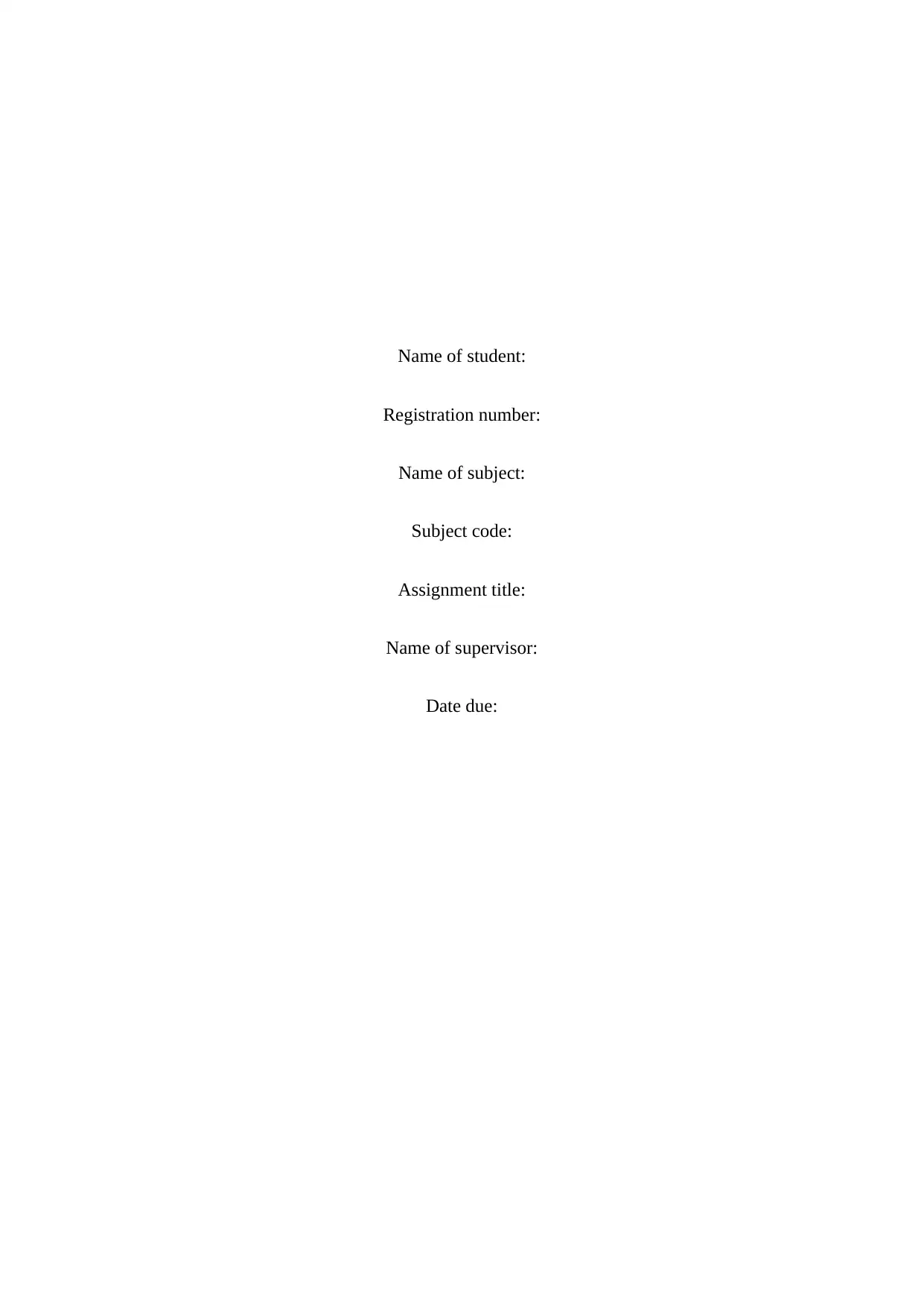
Name of student:
Registration number:
Name of subject:
Subject code:
Assignment title:
Name of supervisor:
Date due:
Registration number:
Name of subject:
Subject code:
Assignment title:
Name of supervisor:
Date due:
Paraphrase This Document
Need a fresh take? Get an instant paraphrase of this document with our AI Paraphraser

Contents
Introduction............................................................................................................................................3
Project summary.....................................................................................................................................3
Evaluation of the partnerships in Habitat 141 project.............................................................................5
Reflection................................................................................................................................................9
Conclusion.............................................................................................................................................11
References............................................................................................................................................ 12
Introduction............................................................................................................................................3
Project summary.....................................................................................................................................3
Evaluation of the partnerships in Habitat 141 project.............................................................................5
Reflection................................................................................................................................................9
Conclusion.............................................................................................................................................11
References............................................................................................................................................ 12
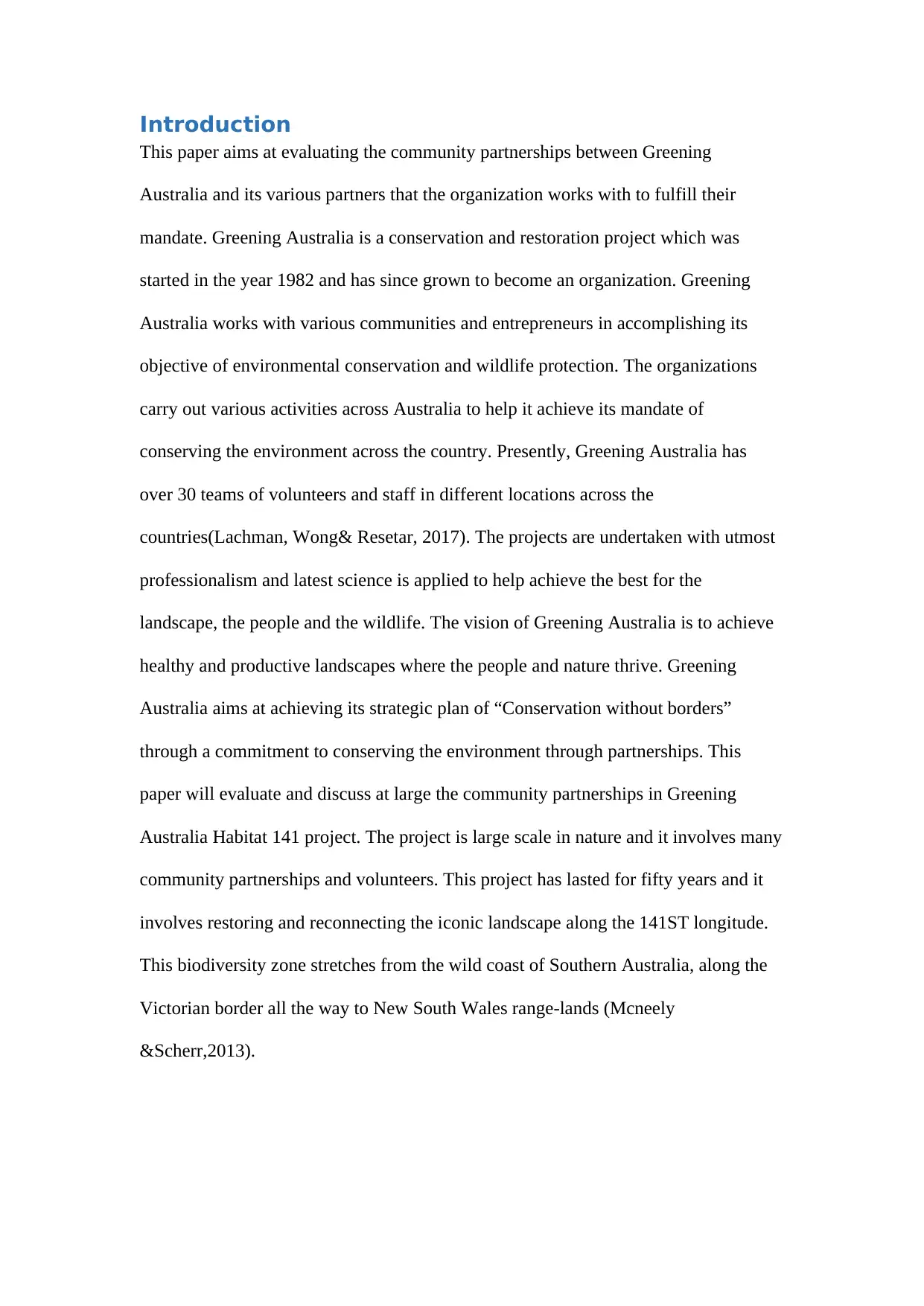
Introduction
This paper aims at evaluating the community partnerships between Greening
Australia and its various partners that the organization works with to fulfill their
mandate. Greening Australia is a conservation and restoration project which was
started in the year 1982 and has since grown to become an organization. Greening
Australia works with various communities and entrepreneurs in accomplishing its
objective of environmental conservation and wildlife protection. The organizations
carry out various activities across Australia to help it achieve its mandate of
conserving the environment across the country. Presently, Greening Australia has
over 30 teams of volunteers and staff in different locations across the
countries(Lachman, Wong& Resetar, 2017). The projects are undertaken with utmost
professionalism and latest science is applied to help achieve the best for the
landscape, the people and the wildlife. The vision of Greening Australia is to achieve
healthy and productive landscapes where the people and nature thrive. Greening
Australia aims at achieving its strategic plan of “Conservation without borders”
through a commitment to conserving the environment through partnerships. This
paper will evaluate and discuss at large the community partnerships in Greening
Australia Habitat 141 project. The project is large scale in nature and it involves many
community partnerships and volunteers. This project has lasted for fifty years and it
involves restoring and reconnecting the iconic landscape along the 141ST longitude.
This biodiversity zone stretches from the wild coast of Southern Australia, along the
Victorian border all the way to New South Wales range-lands (Mcneely
&Scherr,2013).
This paper aims at evaluating the community partnerships between Greening
Australia and its various partners that the organization works with to fulfill their
mandate. Greening Australia is a conservation and restoration project which was
started in the year 1982 and has since grown to become an organization. Greening
Australia works with various communities and entrepreneurs in accomplishing its
objective of environmental conservation and wildlife protection. The organizations
carry out various activities across Australia to help it achieve its mandate of
conserving the environment across the country. Presently, Greening Australia has
over 30 teams of volunteers and staff in different locations across the
countries(Lachman, Wong& Resetar, 2017). The projects are undertaken with utmost
professionalism and latest science is applied to help achieve the best for the
landscape, the people and the wildlife. The vision of Greening Australia is to achieve
healthy and productive landscapes where the people and nature thrive. Greening
Australia aims at achieving its strategic plan of “Conservation without borders”
through a commitment to conserving the environment through partnerships. This
paper will evaluate and discuss at large the community partnerships in Greening
Australia Habitat 141 project. The project is large scale in nature and it involves many
community partnerships and volunteers. This project has lasted for fifty years and it
involves restoring and reconnecting the iconic landscape along the 141ST longitude.
This biodiversity zone stretches from the wild coast of Southern Australia, along the
Victorian border all the way to New South Wales range-lands (Mcneely
&Scherr,2013).
⊘ This is a preview!⊘
Do you want full access?
Subscribe today to unlock all pages.

Trusted by 1+ million students worldwide
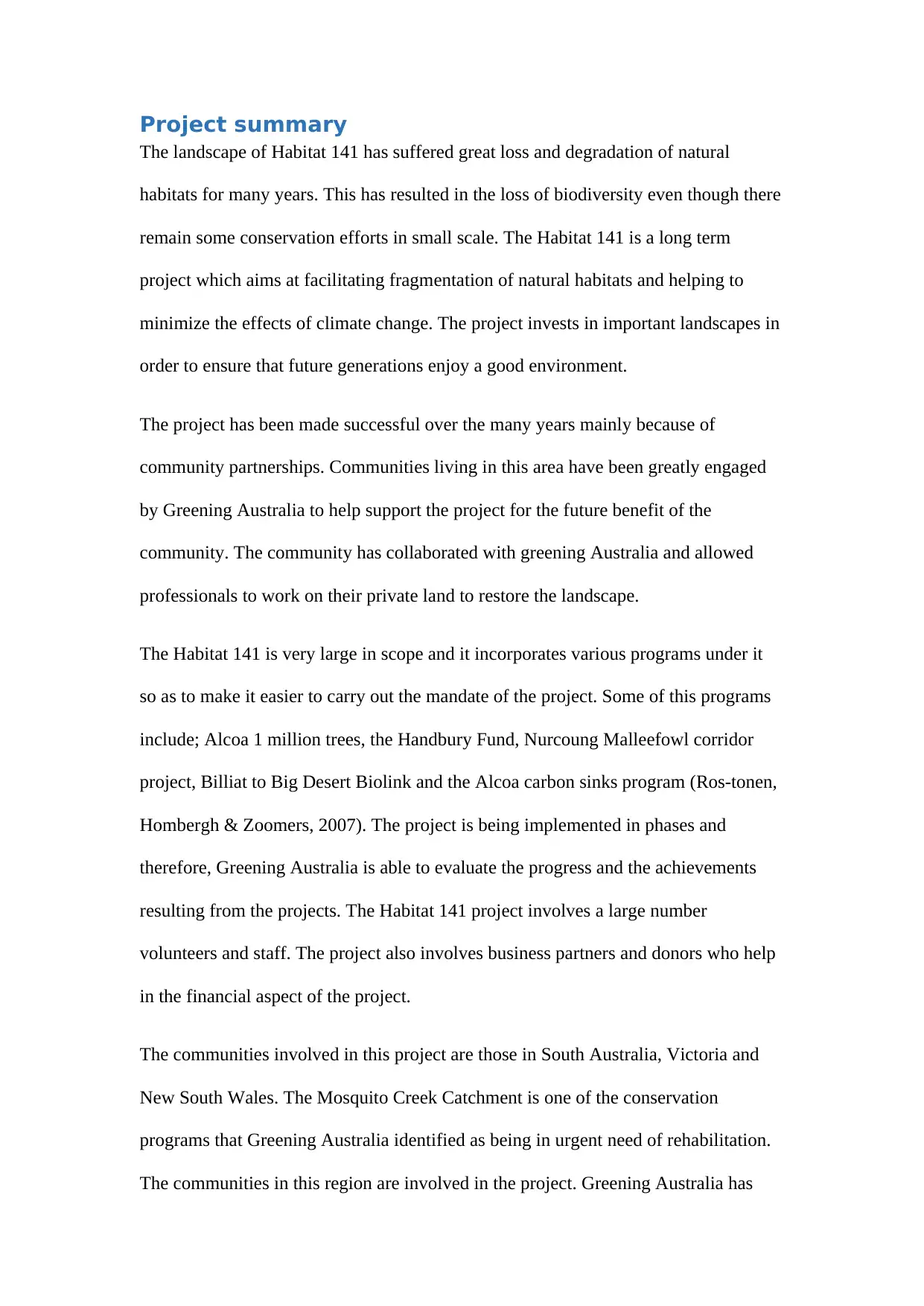
Project summary
The landscape of Habitat 141 has suffered great loss and degradation of natural
habitats for many years. This has resulted in the loss of biodiversity even though there
remain some conservation efforts in small scale. The Habitat 141 is a long term
project which aims at facilitating fragmentation of natural habitats and helping to
minimize the effects of climate change. The project invests in important landscapes in
order to ensure that future generations enjoy a good environment.
The project has been made successful over the many years mainly because of
community partnerships. Communities living in this area have been greatly engaged
by Greening Australia to help support the project for the future benefit of the
community. The community has collaborated with greening Australia and allowed
professionals to work on their private land to restore the landscape.
The Habitat 141 is very large in scope and it incorporates various programs under it
so as to make it easier to carry out the mandate of the project. Some of this programs
include; Alcoa 1 million trees, the Handbury Fund, Nurcoung Malleefowl corridor
project, Billiat to Big Desert Biolink and the Alcoa carbon sinks program (Ros-tonen,
Hombergh & Zoomers, 2007). The project is being implemented in phases and
therefore, Greening Australia is able to evaluate the progress and the achievements
resulting from the projects. The Habitat 141 project involves a large number
volunteers and staff. The project also involves business partners and donors who help
in the financial aspect of the project.
The communities involved in this project are those in South Australia, Victoria and
New South Wales. The Mosquito Creek Catchment is one of the conservation
programs that Greening Australia identified as being in urgent need of rehabilitation.
The communities in this region are involved in the project. Greening Australia has
The landscape of Habitat 141 has suffered great loss and degradation of natural
habitats for many years. This has resulted in the loss of biodiversity even though there
remain some conservation efforts in small scale. The Habitat 141 is a long term
project which aims at facilitating fragmentation of natural habitats and helping to
minimize the effects of climate change. The project invests in important landscapes in
order to ensure that future generations enjoy a good environment.
The project has been made successful over the many years mainly because of
community partnerships. Communities living in this area have been greatly engaged
by Greening Australia to help support the project for the future benefit of the
community. The community has collaborated with greening Australia and allowed
professionals to work on their private land to restore the landscape.
The Habitat 141 is very large in scope and it incorporates various programs under it
so as to make it easier to carry out the mandate of the project. Some of this programs
include; Alcoa 1 million trees, the Handbury Fund, Nurcoung Malleefowl corridor
project, Billiat to Big Desert Biolink and the Alcoa carbon sinks program (Ros-tonen,
Hombergh & Zoomers, 2007). The project is being implemented in phases and
therefore, Greening Australia is able to evaluate the progress and the achievements
resulting from the projects. The Habitat 141 project involves a large number
volunteers and staff. The project also involves business partners and donors who help
in the financial aspect of the project.
The communities involved in this project are those in South Australia, Victoria and
New South Wales. The Mosquito Creek Catchment is one of the conservation
programs that Greening Australia identified as being in urgent need of rehabilitation.
The communities in this region are involved in the project. Greening Australia has
Paraphrase This Document
Need a fresh take? Get an instant paraphrase of this document with our AI Paraphraser
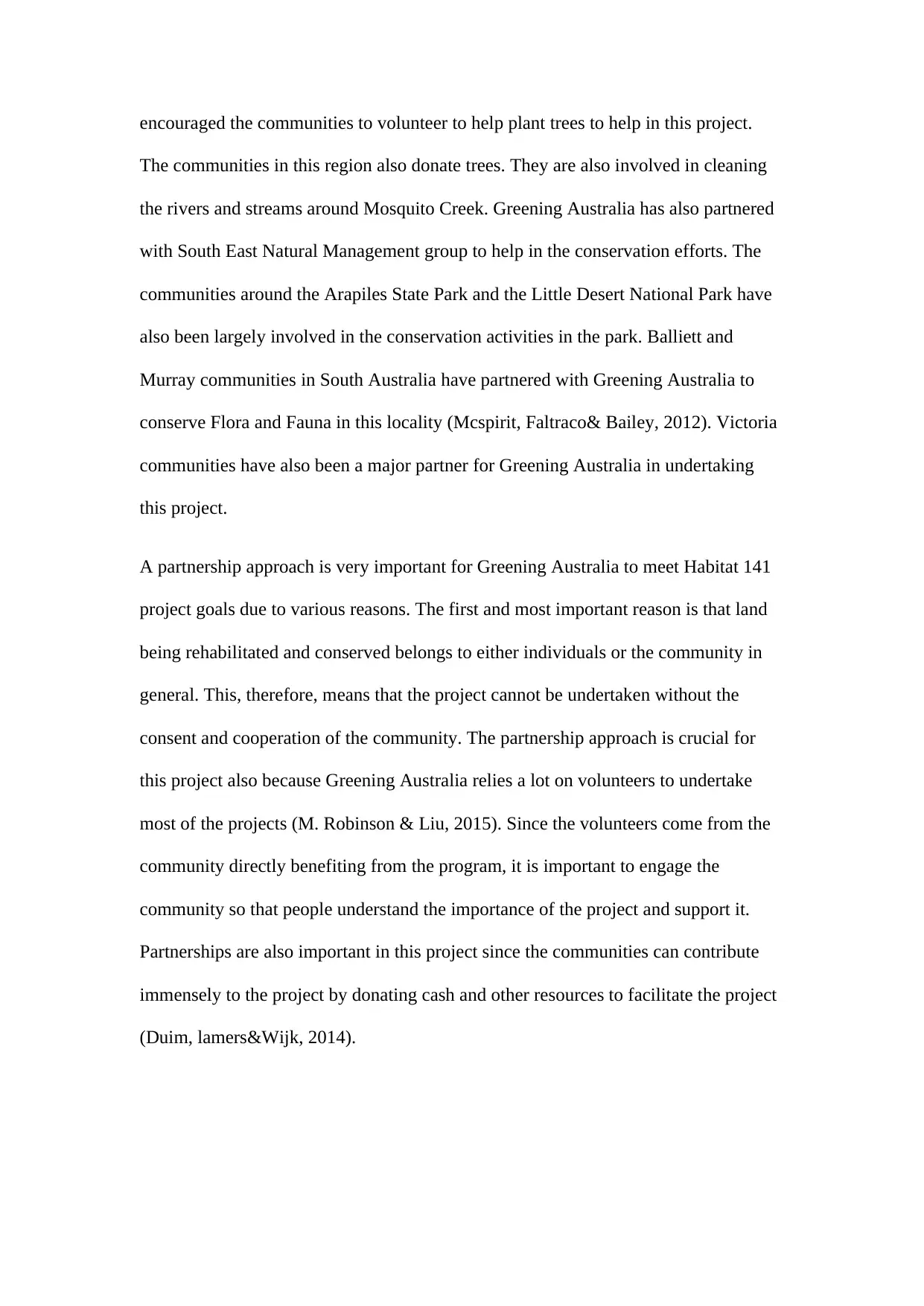
encouraged the communities to volunteer to help plant trees to help in this project.
The communities in this region also donate trees. They are also involved in cleaning
the rivers and streams around Mosquito Creek. Greening Australia has also partnered
with South East Natural Management group to help in the conservation efforts. The
communities around the Arapiles State Park and the Little Desert National Park have
also been largely involved in the conservation activities in the park. Balliett and
Murray communities in South Australia have partnered with Greening Australia to
conserve Flora and Fauna in this locality (Mcspirit, Faltraco& Bailey, 2012). Victoria
communities have also been a major partner for Greening Australia in undertaking
this project.
A partnership approach is very important for Greening Australia to meet Habitat 141
project goals due to various reasons. The first and most important reason is that land
being rehabilitated and conserved belongs to either individuals or the community in
general. This, therefore, means that the project cannot be undertaken without the
consent and cooperation of the community. The partnership approach is crucial for
this project also because Greening Australia relies a lot on volunteers to undertake
most of the projects (M. Robinson & Liu, 2015). Since the volunteers come from the
community directly benefiting from the program, it is important to engage the
community so that people understand the importance of the project and support it.
Partnerships are also important in this project since the communities can contribute
immensely to the project by donating cash and other resources to facilitate the project
(Duim, lamers&Wijk, 2014).
The communities in this region also donate trees. They are also involved in cleaning
the rivers and streams around Mosquito Creek. Greening Australia has also partnered
with South East Natural Management group to help in the conservation efforts. The
communities around the Arapiles State Park and the Little Desert National Park have
also been largely involved in the conservation activities in the park. Balliett and
Murray communities in South Australia have partnered with Greening Australia to
conserve Flora and Fauna in this locality (Mcspirit, Faltraco& Bailey, 2012). Victoria
communities have also been a major partner for Greening Australia in undertaking
this project.
A partnership approach is very important for Greening Australia to meet Habitat 141
project goals due to various reasons. The first and most important reason is that land
being rehabilitated and conserved belongs to either individuals or the community in
general. This, therefore, means that the project cannot be undertaken without the
consent and cooperation of the community. The partnership approach is crucial for
this project also because Greening Australia relies a lot on volunteers to undertake
most of the projects (M. Robinson & Liu, 2015). Since the volunteers come from the
community directly benefiting from the program, it is important to engage the
community so that people understand the importance of the project and support it.
Partnerships are also important in this project since the communities can contribute
immensely to the project by donating cash and other resources to facilitate the project
(Duim, lamers&Wijk, 2014).
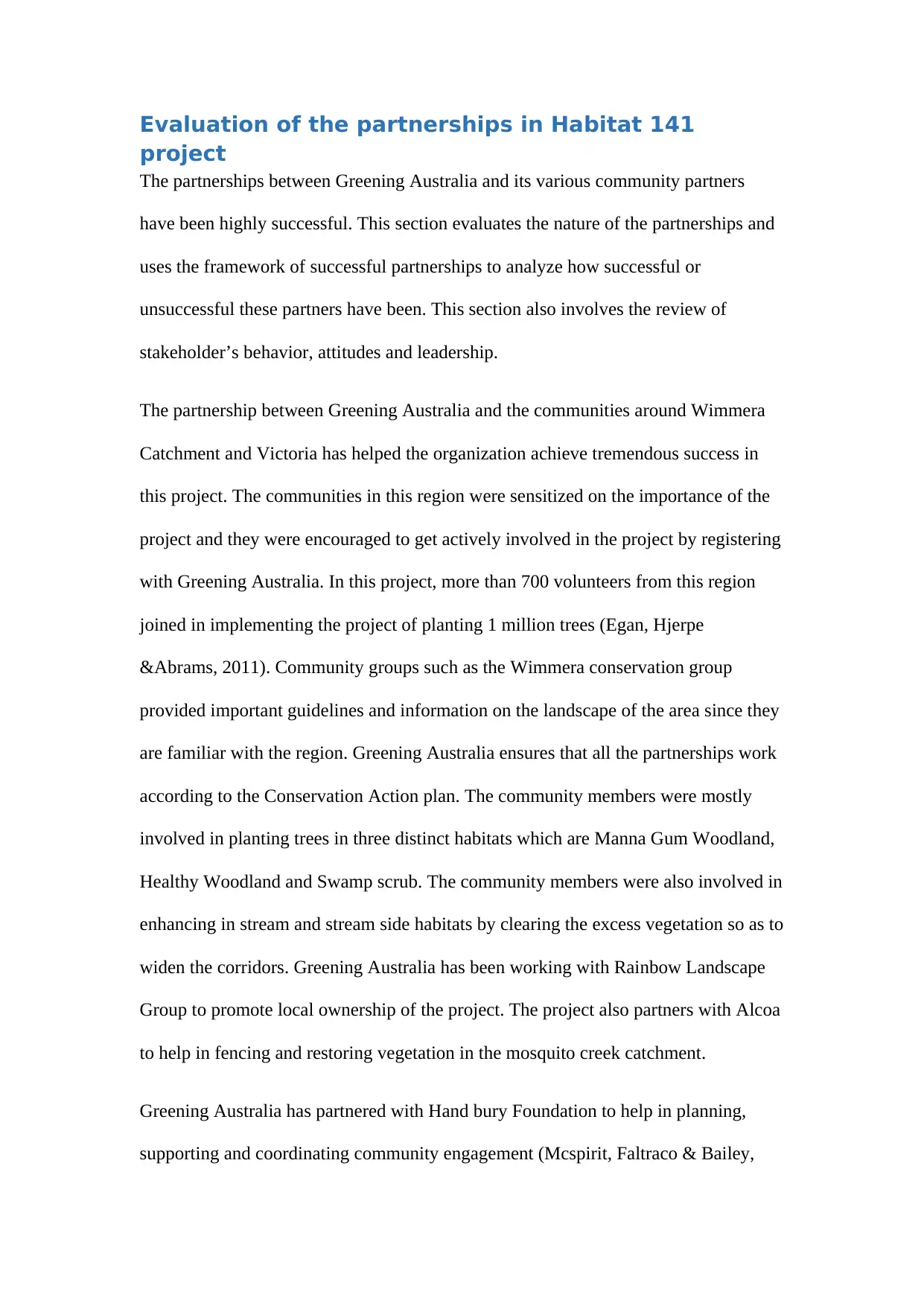
Evaluation of the partnerships in Habitat 141
project
The partnerships between Greening Australia and its various community partners
have been highly successful. This section evaluates the nature of the partnerships and
uses the framework of successful partnerships to analyze how successful or
unsuccessful these partners have been. This section also involves the review of
stakeholder’s behavior, attitudes and leadership.
The partnership between Greening Australia and the communities around Wimmera
Catchment and Victoria has helped the organization achieve tremendous success in
this project. The communities in this region were sensitized on the importance of the
project and they were encouraged to get actively involved in the project by registering
with Greening Australia. In this project, more than 700 volunteers from this region
joined in implementing the project of planting 1 million trees (Egan, Hjerpe
&Abrams, 2011). Community groups such as the Wimmera conservation group
provided important guidelines and information on the landscape of the area since they
are familiar with the region. Greening Australia ensures that all the partnerships work
according to the Conservation Action plan. The community members were mostly
involved in planting trees in three distinct habitats which are Manna Gum Woodland,
Healthy Woodland and Swamp scrub. The community members were also involved in
enhancing in stream and stream side habitats by clearing the excess vegetation so as to
widen the corridors. Greening Australia has been working with Rainbow Landscape
Group to promote local ownership of the project. The project also partners with Alcoa
to help in fencing and restoring vegetation in the mosquito creek catchment.
Greening Australia has partnered with Hand bury Foundation to help in planning,
supporting and coordinating community engagement (Mcspirit, Faltraco & Bailey,
project
The partnerships between Greening Australia and its various community partners
have been highly successful. This section evaluates the nature of the partnerships and
uses the framework of successful partnerships to analyze how successful or
unsuccessful these partners have been. This section also involves the review of
stakeholder’s behavior, attitudes and leadership.
The partnership between Greening Australia and the communities around Wimmera
Catchment and Victoria has helped the organization achieve tremendous success in
this project. The communities in this region were sensitized on the importance of the
project and they were encouraged to get actively involved in the project by registering
with Greening Australia. In this project, more than 700 volunteers from this region
joined in implementing the project of planting 1 million trees (Egan, Hjerpe
&Abrams, 2011). Community groups such as the Wimmera conservation group
provided important guidelines and information on the landscape of the area since they
are familiar with the region. Greening Australia ensures that all the partnerships work
according to the Conservation Action plan. The community members were mostly
involved in planting trees in three distinct habitats which are Manna Gum Woodland,
Healthy Woodland and Swamp scrub. The community members were also involved in
enhancing in stream and stream side habitats by clearing the excess vegetation so as to
widen the corridors. Greening Australia has been working with Rainbow Landscape
Group to promote local ownership of the project. The project also partners with Alcoa
to help in fencing and restoring vegetation in the mosquito creek catchment.
Greening Australia has partnered with Hand bury Foundation to help in planning,
supporting and coordinating community engagement (Mcspirit, Faltraco & Bailey,
⊘ This is a preview!⊘
Do you want full access?
Subscribe today to unlock all pages.

Trusted by 1+ million students worldwide
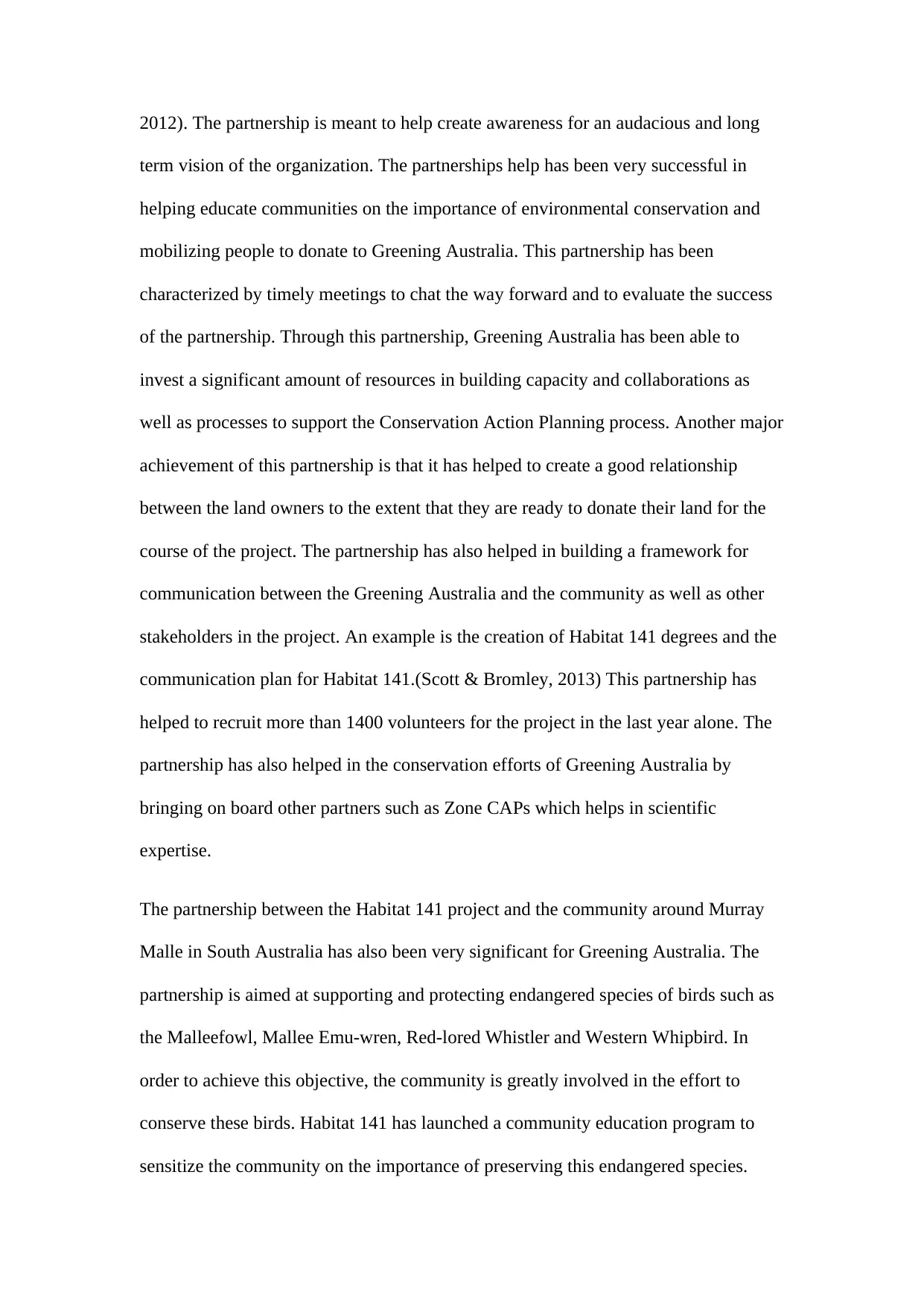
2012). The partnership is meant to help create awareness for an audacious and long
term vision of the organization. The partnerships help has been very successful in
helping educate communities on the importance of environmental conservation and
mobilizing people to donate to Greening Australia. This partnership has been
characterized by timely meetings to chat the way forward and to evaluate the success
of the partnership. Through this partnership, Greening Australia has been able to
invest a significant amount of resources in building capacity and collaborations as
well as processes to support the Conservation Action Planning process. Another major
achievement of this partnership is that it has helped to create a good relationship
between the land owners to the extent that they are ready to donate their land for the
course of the project. The partnership has also helped in building a framework for
communication between the Greening Australia and the community as well as other
stakeholders in the project. An example is the creation of Habitat 141 degrees and the
communication plan for Habitat 141.(Scott & Bromley, 2013) This partnership has
helped to recruit more than 1400 volunteers for the project in the last year alone. The
partnership has also helped in the conservation efforts of Greening Australia by
bringing on board other partners such as Zone CAPs which helps in scientific
expertise.
The partnership between the Habitat 141 project and the community around Murray
Malle in South Australia has also been very significant for Greening Australia. The
partnership is aimed at supporting and protecting endangered species of birds such as
the Malleefowl, Mallee Emu-wren, Red-lored Whistler and Western Whipbird. In
order to achieve this objective, the community is greatly involved in the effort to
conserve these birds. Habitat 141 has launched a community education program to
sensitize the community on the importance of preserving this endangered species.
term vision of the organization. The partnerships help has been very successful in
helping educate communities on the importance of environmental conservation and
mobilizing people to donate to Greening Australia. This partnership has been
characterized by timely meetings to chat the way forward and to evaluate the success
of the partnership. Through this partnership, Greening Australia has been able to
invest a significant amount of resources in building capacity and collaborations as
well as processes to support the Conservation Action Planning process. Another major
achievement of this partnership is that it has helped to create a good relationship
between the land owners to the extent that they are ready to donate their land for the
course of the project. The partnership has also helped in building a framework for
communication between the Greening Australia and the community as well as other
stakeholders in the project. An example is the creation of Habitat 141 degrees and the
communication plan for Habitat 141.(Scott & Bromley, 2013) This partnership has
helped to recruit more than 1400 volunteers for the project in the last year alone. The
partnership has also helped in the conservation efforts of Greening Australia by
bringing on board other partners such as Zone CAPs which helps in scientific
expertise.
The partnership between the Habitat 141 project and the community around Murray
Malle in South Australia has also been very significant for Greening Australia. The
partnership is aimed at supporting and protecting endangered species of birds such as
the Malleefowl, Mallee Emu-wren, Red-lored Whistler and Western Whipbird. In
order to achieve this objective, the community is greatly involved in the effort to
conserve these birds. Habitat 141 has launched a community education program to
sensitize the community on the importance of preserving this endangered species.
Paraphrase This Document
Need a fresh take? Get an instant paraphrase of this document with our AI Paraphraser
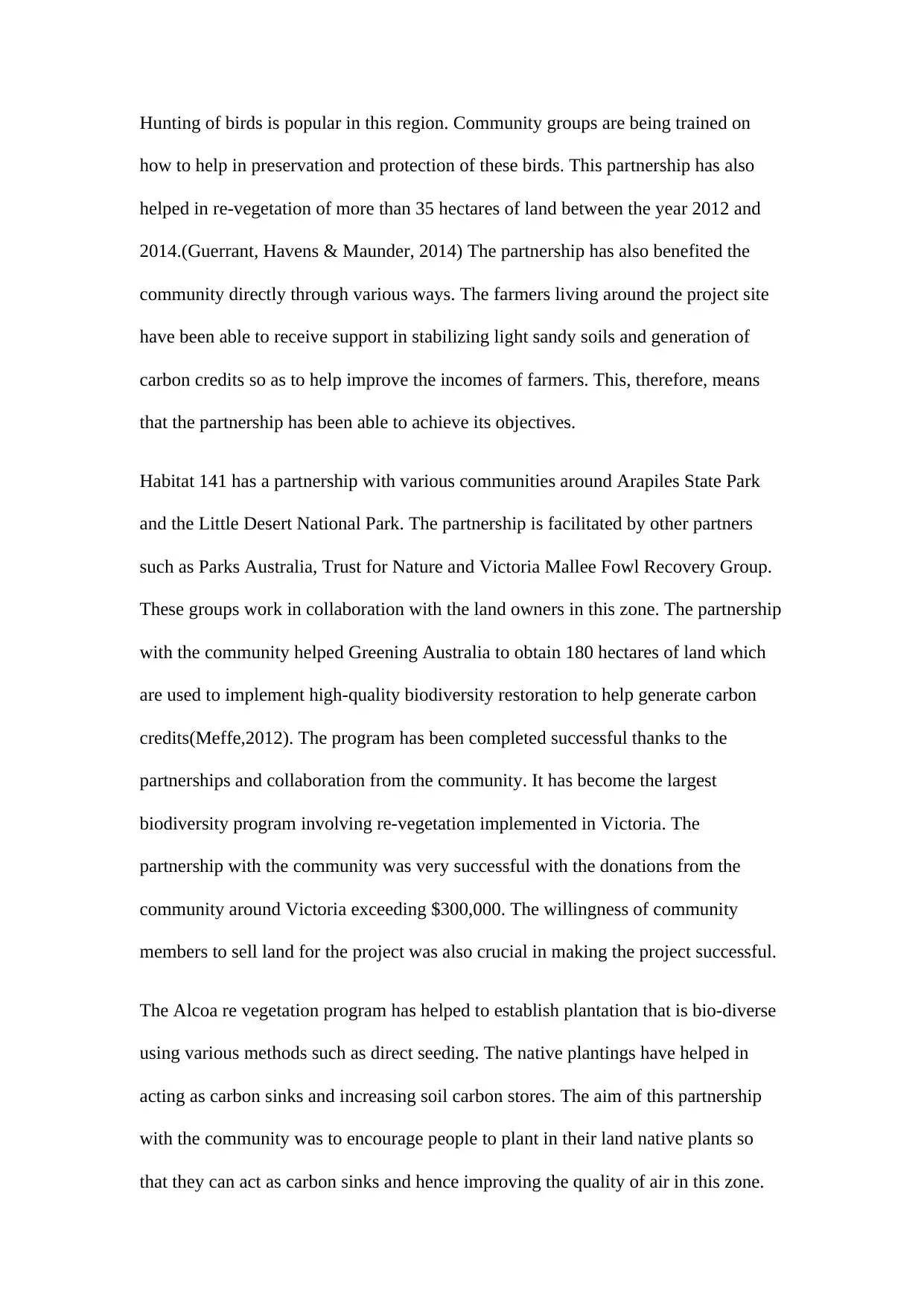
Hunting of birds is popular in this region. Community groups are being trained on
how to help in preservation and protection of these birds. This partnership has also
helped in re-vegetation of more than 35 hectares of land between the year 2012 and
2014.(Guerrant, Havens & Maunder, 2014) The partnership has also benefited the
community directly through various ways. The farmers living around the project site
have been able to receive support in stabilizing light sandy soils and generation of
carbon credits so as to help improve the incomes of farmers. This, therefore, means
that the partnership has been able to achieve its objectives.
Habitat 141 has a partnership with various communities around Arapiles State Park
and the Little Desert National Park. The partnership is facilitated by other partners
such as Parks Australia, Trust for Nature and Victoria Mallee Fowl Recovery Group.
These groups work in collaboration with the land owners in this zone. The partnership
with the community helped Greening Australia to obtain 180 hectares of land which
are used to implement high-quality biodiversity restoration to help generate carbon
credits(Meffe,2012). The program has been completed successful thanks to the
partnerships and collaboration from the community. It has become the largest
biodiversity program involving re-vegetation implemented in Victoria. The
partnership with the community was very successful with the donations from the
community around Victoria exceeding $300,000. The willingness of community
members to sell land for the project was also crucial in making the project successful.
The Alcoa re vegetation program has helped to establish plantation that is bio-diverse
using various methods such as direct seeding. The native plantings have helped in
acting as carbon sinks and increasing soil carbon stores. The aim of this partnership
with the community was to encourage people to plant in their land native plants so
that they can act as carbon sinks and hence improving the quality of air in this zone.
how to help in preservation and protection of these birds. This partnership has also
helped in re-vegetation of more than 35 hectares of land between the year 2012 and
2014.(Guerrant, Havens & Maunder, 2014) The partnership has also benefited the
community directly through various ways. The farmers living around the project site
have been able to receive support in stabilizing light sandy soils and generation of
carbon credits so as to help improve the incomes of farmers. This, therefore, means
that the partnership has been able to achieve its objectives.
Habitat 141 has a partnership with various communities around Arapiles State Park
and the Little Desert National Park. The partnership is facilitated by other partners
such as Parks Australia, Trust for Nature and Victoria Mallee Fowl Recovery Group.
These groups work in collaboration with the land owners in this zone. The partnership
with the community helped Greening Australia to obtain 180 hectares of land which
are used to implement high-quality biodiversity restoration to help generate carbon
credits(Meffe,2012). The program has been completed successful thanks to the
partnerships and collaboration from the community. It has become the largest
biodiversity program involving re-vegetation implemented in Victoria. The
partnership with the community was very successful with the donations from the
community around Victoria exceeding $300,000. The willingness of community
members to sell land for the project was also crucial in making the project successful.
The Alcoa re vegetation program has helped to establish plantation that is bio-diverse
using various methods such as direct seeding. The native plantings have helped in
acting as carbon sinks and increasing soil carbon stores. The aim of this partnership
with the community was to encourage people to plant in their land native plants so
that they can act as carbon sinks and hence improving the quality of air in this zone.
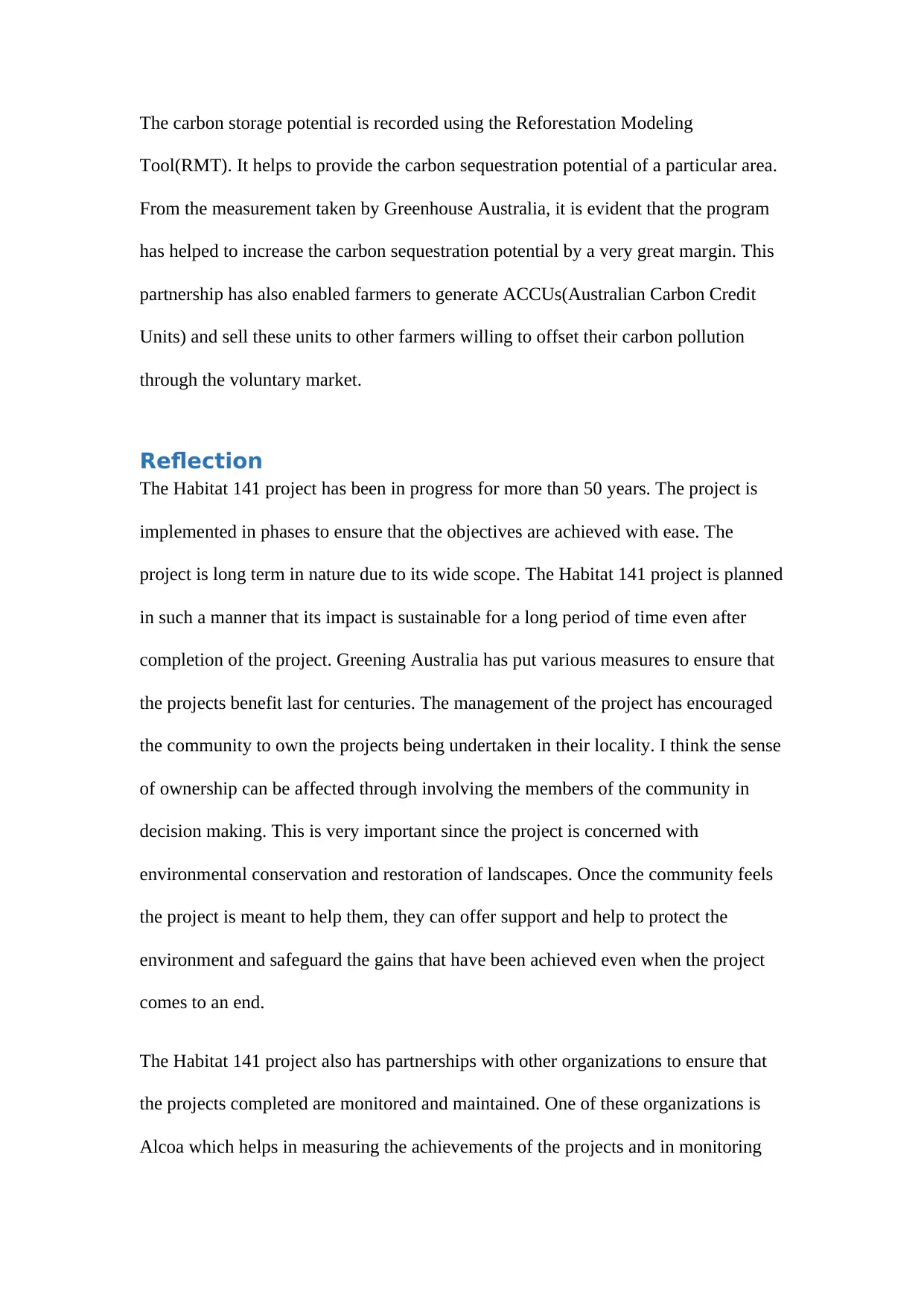
The carbon storage potential is recorded using the Reforestation Modeling
Tool(RMT). It helps to provide the carbon sequestration potential of a particular area.
From the measurement taken by Greenhouse Australia, it is evident that the program
has helped to increase the carbon sequestration potential by a very great margin. This
partnership has also enabled farmers to generate ACCUs(Australian Carbon Credit
Units) and sell these units to other farmers willing to offset their carbon pollution
through the voluntary market.
Reflection
The Habitat 141 project has been in progress for more than 50 years. The project is
implemented in phases to ensure that the objectives are achieved with ease. The
project is long term in nature due to its wide scope. The Habitat 141 project is planned
in such a manner that its impact is sustainable for a long period of time even after
completion of the project. Greening Australia has put various measures to ensure that
the projects benefit last for centuries. The management of the project has encouraged
the community to own the projects being undertaken in their locality. I think the sense
of ownership can be affected through involving the members of the community in
decision making. This is very important since the project is concerned with
environmental conservation and restoration of landscapes. Once the community feels
the project is meant to help them, they can offer support and help to protect the
environment and safeguard the gains that have been achieved even when the project
comes to an end.
The Habitat 141 project also has partnerships with other organizations to ensure that
the projects completed are monitored and maintained. One of these organizations is
Alcoa which helps in measuring the achievements of the projects and in monitoring
Tool(RMT). It helps to provide the carbon sequestration potential of a particular area.
From the measurement taken by Greenhouse Australia, it is evident that the program
has helped to increase the carbon sequestration potential by a very great margin. This
partnership has also enabled farmers to generate ACCUs(Australian Carbon Credit
Units) and sell these units to other farmers willing to offset their carbon pollution
through the voluntary market.
Reflection
The Habitat 141 project has been in progress for more than 50 years. The project is
implemented in phases to ensure that the objectives are achieved with ease. The
project is long term in nature due to its wide scope. The Habitat 141 project is planned
in such a manner that its impact is sustainable for a long period of time even after
completion of the project. Greening Australia has put various measures to ensure that
the projects benefit last for centuries. The management of the project has encouraged
the community to own the projects being undertaken in their locality. I think the sense
of ownership can be affected through involving the members of the community in
decision making. This is very important since the project is concerned with
environmental conservation and restoration of landscapes. Once the community feels
the project is meant to help them, they can offer support and help to protect the
environment and safeguard the gains that have been achieved even when the project
comes to an end.
The Habitat 141 project also has partnerships with other organizations to ensure that
the projects completed are monitored and maintained. One of these organizations is
Alcoa which helps in measuring the achievements of the projects and in monitoring
⊘ This is a preview!⊘
Do you want full access?
Subscribe today to unlock all pages.

Trusted by 1+ million students worldwide
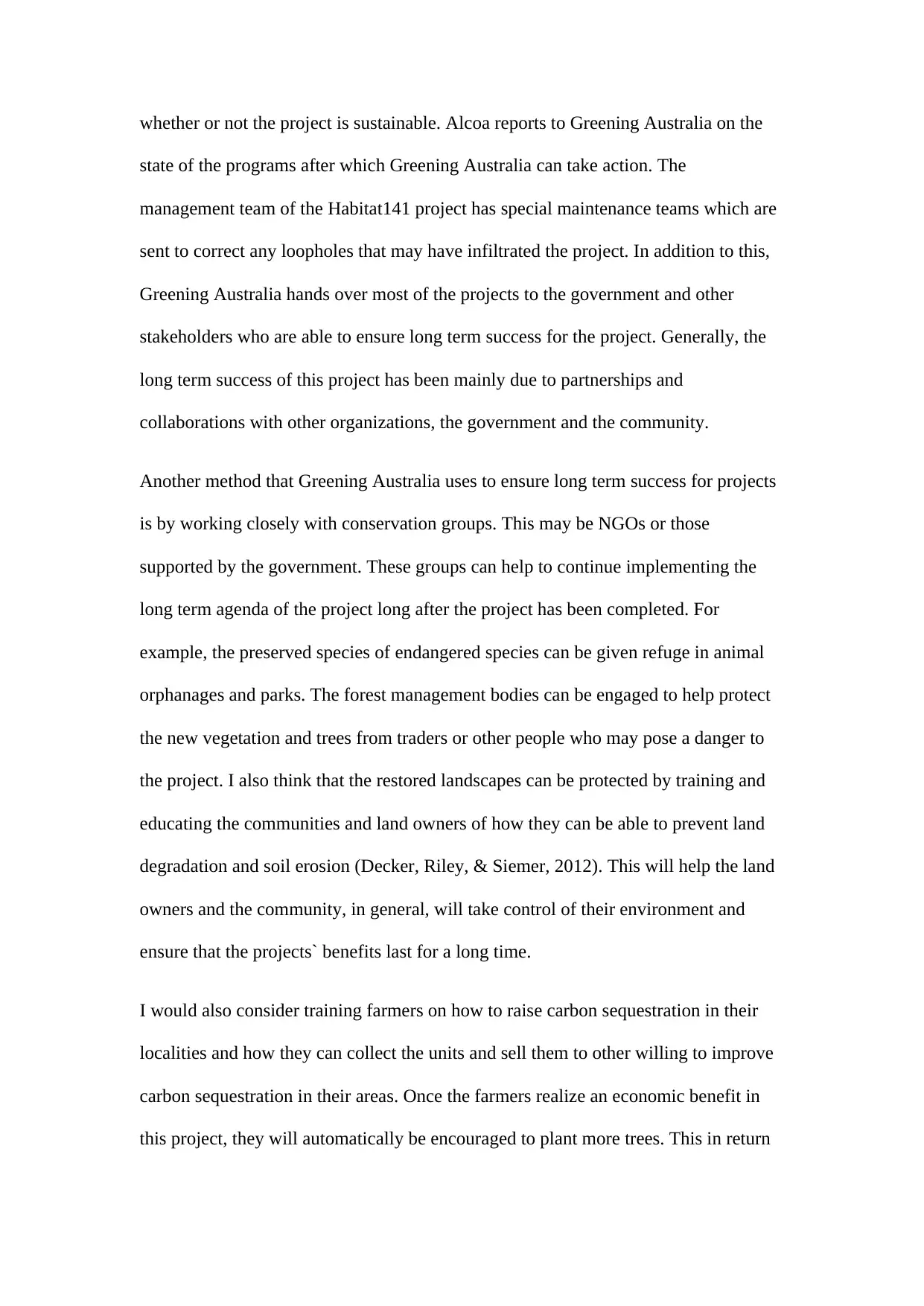
whether or not the project is sustainable. Alcoa reports to Greening Australia on the
state of the programs after which Greening Australia can take action. The
management team of the Habitat141 project has special maintenance teams which are
sent to correct any loopholes that may have infiltrated the project. In addition to this,
Greening Australia hands over most of the projects to the government and other
stakeholders who are able to ensure long term success for the project. Generally, the
long term success of this project has been mainly due to partnerships and
collaborations with other organizations, the government and the community.
Another method that Greening Australia uses to ensure long term success for projects
is by working closely with conservation groups. This may be NGOs or those
supported by the government. These groups can help to continue implementing the
long term agenda of the project long after the project has been completed. For
example, the preserved species of endangered species can be given refuge in animal
orphanages and parks. The forest management bodies can be engaged to help protect
the new vegetation and trees from traders or other people who may pose a danger to
the project. I also think that the restored landscapes can be protected by training and
educating the communities and land owners of how they can be able to prevent land
degradation and soil erosion (Decker, Riley, & Siemer, 2012). This will help the land
owners and the community, in general, will take control of their environment and
ensure that the projects` benefits last for a long time.
I would also consider training farmers on how to raise carbon sequestration in their
localities and how they can collect the units and sell them to other willing to improve
carbon sequestration in their areas. Once the farmers realize an economic benefit in
this project, they will automatically be encouraged to plant more trees. This in return
state of the programs after which Greening Australia can take action. The
management team of the Habitat141 project has special maintenance teams which are
sent to correct any loopholes that may have infiltrated the project. In addition to this,
Greening Australia hands over most of the projects to the government and other
stakeholders who are able to ensure long term success for the project. Generally, the
long term success of this project has been mainly due to partnerships and
collaborations with other organizations, the government and the community.
Another method that Greening Australia uses to ensure long term success for projects
is by working closely with conservation groups. This may be NGOs or those
supported by the government. These groups can help to continue implementing the
long term agenda of the project long after the project has been completed. For
example, the preserved species of endangered species can be given refuge in animal
orphanages and parks. The forest management bodies can be engaged to help protect
the new vegetation and trees from traders or other people who may pose a danger to
the project. I also think that the restored landscapes can be protected by training and
educating the communities and land owners of how they can be able to prevent land
degradation and soil erosion (Decker, Riley, & Siemer, 2012). This will help the land
owners and the community, in general, will take control of their environment and
ensure that the projects` benefits last for a long time.
I would also consider training farmers on how to raise carbon sequestration in their
localities and how they can collect the units and sell them to other willing to improve
carbon sequestration in their areas. Once the farmers realize an economic benefit in
this project, they will automatically be encouraged to plant more trees. This in return
Paraphrase This Document
Need a fresh take? Get an instant paraphrase of this document with our AI Paraphraser
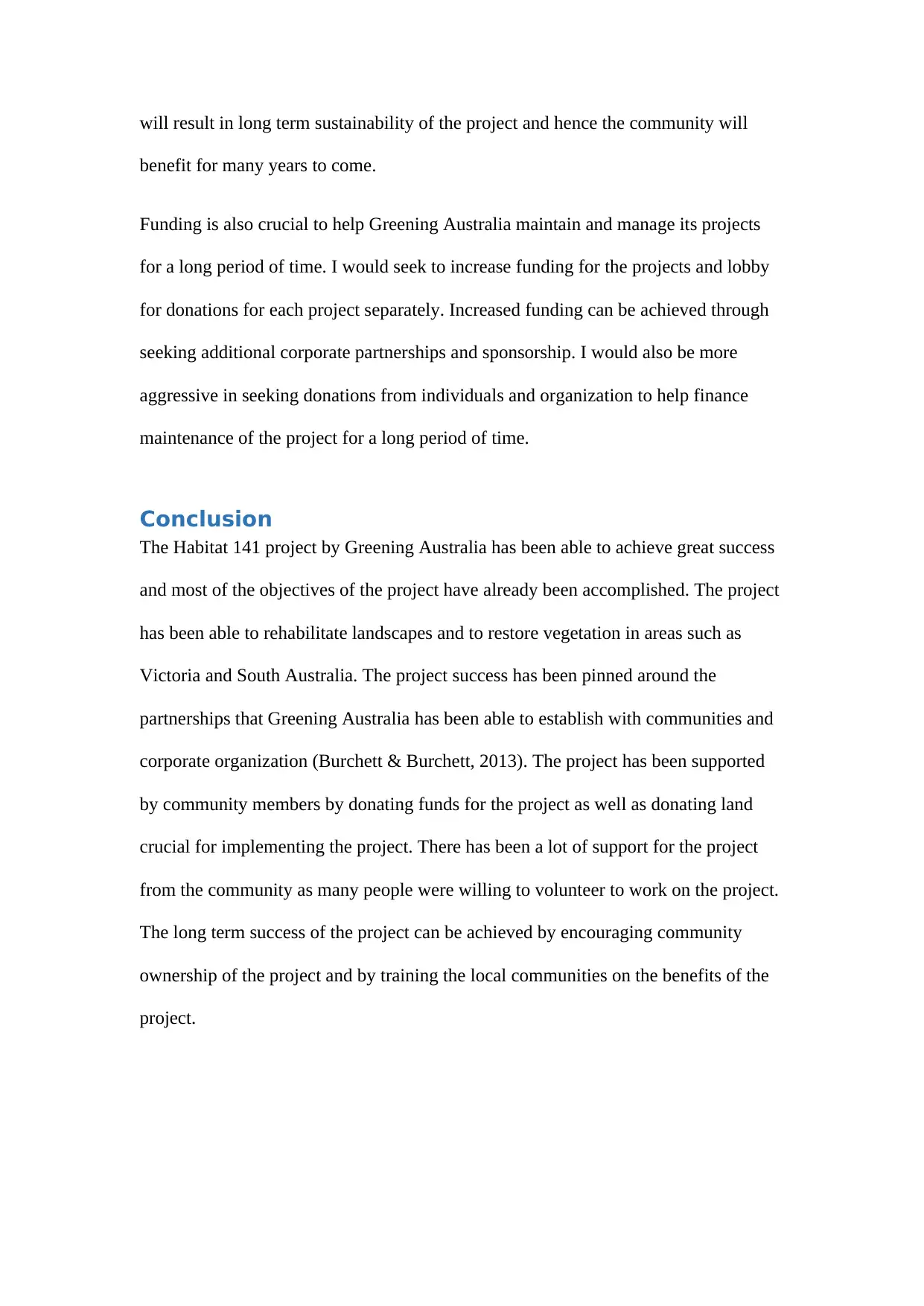
will result in long term sustainability of the project and hence the community will
benefit for many years to come.
Funding is also crucial to help Greening Australia maintain and manage its projects
for a long period of time. I would seek to increase funding for the projects and lobby
for donations for each project separately. Increased funding can be achieved through
seeking additional corporate partnerships and sponsorship. I would also be more
aggressive in seeking donations from individuals and organization to help finance
maintenance of the project for a long period of time.
Conclusion
The Habitat 141 project by Greening Australia has been able to achieve great success
and most of the objectives of the project have already been accomplished. The project
has been able to rehabilitate landscapes and to restore vegetation in areas such as
Victoria and South Australia. The project success has been pinned around the
partnerships that Greening Australia has been able to establish with communities and
corporate organization (Burchett & Burchett, 2013). The project has been supported
by community members by donating funds for the project as well as donating land
crucial for implementing the project. There has been a lot of support for the project
from the community as many people were willing to volunteer to work on the project.
The long term success of the project can be achieved by encouraging community
ownership of the project and by training the local communities on the benefits of the
project.
benefit for many years to come.
Funding is also crucial to help Greening Australia maintain and manage its projects
for a long period of time. I would seek to increase funding for the projects and lobby
for donations for each project separately. Increased funding can be achieved through
seeking additional corporate partnerships and sponsorship. I would also be more
aggressive in seeking donations from individuals and organization to help finance
maintenance of the project for a long period of time.
Conclusion
The Habitat 141 project by Greening Australia has been able to achieve great success
and most of the objectives of the project have already been accomplished. The project
has been able to rehabilitate landscapes and to restore vegetation in areas such as
Victoria and South Australia. The project success has been pinned around the
partnerships that Greening Australia has been able to establish with communities and
corporate organization (Burchett & Burchett, 2013). The project has been supported
by community members by donating funds for the project as well as donating land
crucial for implementing the project. There has been a lot of support for the project
from the community as many people were willing to volunteer to work on the project.
The long term success of the project can be achieved by encouraging community
ownership of the project and by training the local communities on the benefits of the
project.
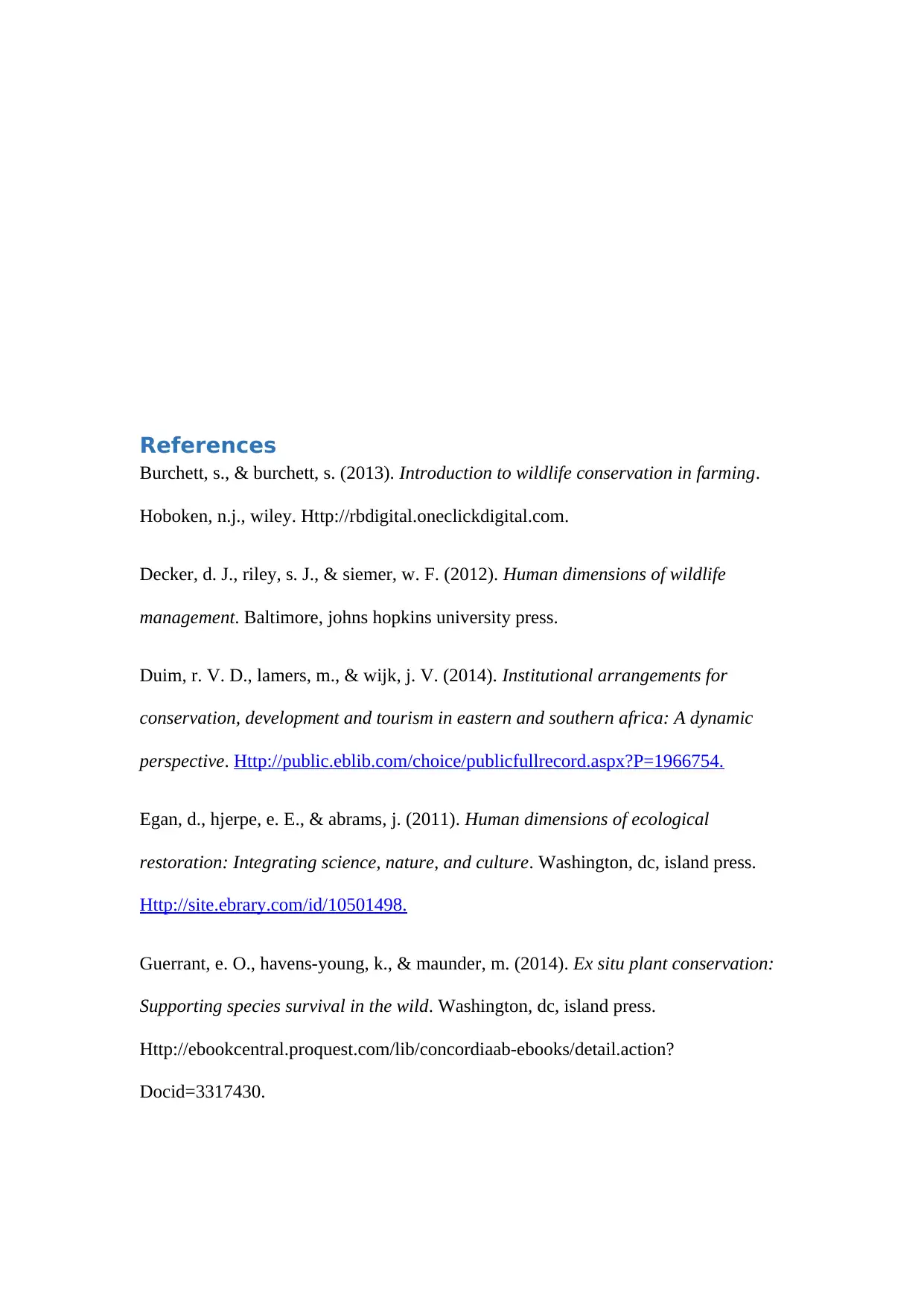
References
Burchett, s., & burchett, s. (2013). Introduction to wildlife conservation in farming.
Hoboken, n.j., wiley. Http://rbdigital.oneclickdigital.com.
Decker, d. J., riley, s. J., & siemer, w. F. (2012). Human dimensions of wildlife
management. Baltimore, johns hopkins university press.
Duim, r. V. D., lamers, m., & wijk, j. V. (2014). Institutional arrangements for
conservation, development and tourism in eastern and southern africa: A dynamic
perspective. Http://public.eblib.com/choice/publicfullrecord.aspx?P=1966754.
Egan, d., hjerpe, e. E., & abrams, j. (2011). Human dimensions of ecological
restoration: Integrating science, nature, and culture. Washington, dc, island press.
Http://site.ebrary.com/id/10501498.
Guerrant, e. O., havens-young, k., & maunder, m. (2014). Ex situ plant conservation:
Supporting species survival in the wild. Washington, dc, island press.
Http://ebookcentral.proquest.com/lib/concordiaab-ebooks/detail.action?
Docid=3317430.
Burchett, s., & burchett, s. (2013). Introduction to wildlife conservation in farming.
Hoboken, n.j., wiley. Http://rbdigital.oneclickdigital.com.
Decker, d. J., riley, s. J., & siemer, w. F. (2012). Human dimensions of wildlife
management. Baltimore, johns hopkins university press.
Duim, r. V. D., lamers, m., & wijk, j. V. (2014). Institutional arrangements for
conservation, development and tourism in eastern and southern africa: A dynamic
perspective. Http://public.eblib.com/choice/publicfullrecord.aspx?P=1966754.
Egan, d., hjerpe, e. E., & abrams, j. (2011). Human dimensions of ecological
restoration: Integrating science, nature, and culture. Washington, dc, island press.
Http://site.ebrary.com/id/10501498.
Guerrant, e. O., havens-young, k., & maunder, m. (2014). Ex situ plant conservation:
Supporting species survival in the wild. Washington, dc, island press.
Http://ebookcentral.proquest.com/lib/concordiaab-ebooks/detail.action?
Docid=3317430.
⊘ This is a preview!⊘
Do you want full access?
Subscribe today to unlock all pages.

Trusted by 1+ million students worldwide
1 out of 14
Related Documents
Your All-in-One AI-Powered Toolkit for Academic Success.
+13062052269
info@desklib.com
Available 24*7 on WhatsApp / Email
![[object Object]](/_next/static/media/star-bottom.7253800d.svg)
Unlock your academic potential
Copyright © 2020–2025 A2Z Services. All Rights Reserved. Developed and managed by ZUCOL.





